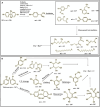Solubilization and enhanced degradation of benzene phenolic derivatives-Bisphenol A/Triclosan using a biosurfactant producing white rot fungus Hypocrea lixii S5 with plant growth promoting traits
- PMID: 39360314
- PMCID: PMC11445159
- DOI: 10.3389/fmicb.2024.1433745
Solubilization and enhanced degradation of benzene phenolic derivatives-Bisphenol A/Triclosan using a biosurfactant producing white rot fungus Hypocrea lixii S5 with plant growth promoting traits
Abstract
Introduction: Endocrine disrupting chemicals (EDCs) as benzene phenolic derivatives being hydrophobic partition to organic matter in sludge/soil sediments and show slow degradation rate owing to poor bioavailability to microbes.
Methods: In the present study, the potential of a versatile white rot fungal isolate S5 identified as Hypocrea lixii was monitored to degrade bisphenol A (BPA)/triclosan (TCS) under shake flask conditions with concomitant production of lipopeptide biosurfactant (BS) and plant growth promotion.
Results: Sufficient growth of WRF for 5 days before supplementation of 50 ppm EDC (BPA/TCS) in set B showed an increase in degradation rates by 23% and 29% with corresponding increase in secretion of lignin-modifying enzymes compared to set A wherein almost 84% and 97% inhibition in fungal growth was observed when BPA/TCS were added at time of fungal inoculation. Further in set B, EDC concentration stimulated expression of laccase and lignin peroxidase (Lip) with 24.44 U/L of laccase and 281.69 U/L of Lip in 100 ppm BPA and 344 U/L Lip in 50 ppm TCS supplemented medium compared to their respective controls (without EDC). Biodegradation was also found to be correlated with lowering of surface tension from 57.02 mN/m (uninoculated control) to 44.16 mN/m in case of BPA and 38.49 mN/m in TCS, indicative of biosurfactant (BS) production. FTIR, GC-MS, and LC-ESI/MSMS confirmed the presence of surfactin lipopeptide isoforms. The WRF also displayed positive plant growth promoting traits as production of ammonia, indole acetic acid, siderophores, Zn solubilization, and 1-1-aminocyclopropane-1-carboxylate (ACC) deaminase activity, reflecting its soil restoration ability.
Discussion: The combined traits of biosurfactant production, EDC degradation and plant growth promotion displayed by WRF will help in emulsifying the hydrophobic pollutants favoring their fast degradation along with restoration of contaminated soil in natural conditions.
Keywords: bioaccumulation; degradation correlation; lignin-modifying enzymes; lipopeptide; metabolic pathway.
Copyright © 2024 Chaturvedi, Kaur, Rahman and Sharma.
Conflict of interest statement
The authors declare that the research was conducted in the absence of any commercial or financial relationships that could be construed as a potential conflict of interest.
Figures









References
-
- Asif M. B., Hai F. I., Hou J., Price W. E., Nghiem L. D. (2017). Impact of wastewater derived dissolved interfering compounds on growth, enzymatic activity and trace organic contaminant removal of white rot fungi–a critical review. J. Environ. Manage. 201, 89–109. 10.1016/j.jenvman.2017.06.014 - DOI - PubMed
LinkOut - more resources
Full Text Sources
Miscellaneous

